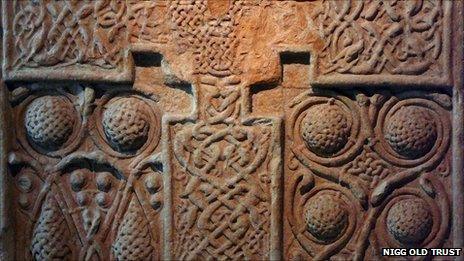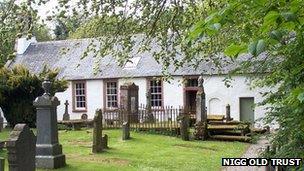Funds secured for Easter Ross's Pictish Nigg cross-slab
- Published

Detail on the Nigg cross-slab which dates from the 8th Century AD
A small voluntary group has secured enough money to conserve and redesign the displaying of an intricately carved Pictish stone in Easter Ross.
The Nigg cross-slab dates from the 8th Century AD and features snakes and a depiction of monks receiving bread from a raven sent by God.
Nigg Old Trust has received a funding package of £178,000.
The Heritage Lottery Fund, Scottish government and European Community Highland Leader fund contributed.
The stone is displayed at Nigg Old Church.
Liz Budge, of Nigg Old Trust, said the financial package was crucial to the conservation of the stone.
She said: "We are a small group of local volunteers and, without support from organisations such as Heritage Lottery Fund and the Highland Leader Programme, would be unable to carry out this project.

The stone is displayed inside Nigg Old Church
"This funding will allow us to complete the final phase of an ambitious programme which has already seen us successfully complete major refurbishments to the church."
The cross-slab is one of Scotland's greatest art treasures, according to the trust.
The stone's entry in the Highland Historic Environment database, external described it as being intricately carved.
The entry said: "The style echoes that of the the sculptured crosses on Iona, the Book of Kells, and illustrated manuscripts of Lindisfarne in Northumbria and Durrow in Ireland.
"It seems always to have stood in the churchyard at Nigg."
In 1727 it was blown down in a storm but re-erected against the east gable of the church, according to the database.
In later years it was broken while being moved to give access to a burial vault and re-erected upside down. Eventually it was moved inside the church.
A broken piece of the cross-slab was found in a nearby burn in 1998.
- Published14 September 2011